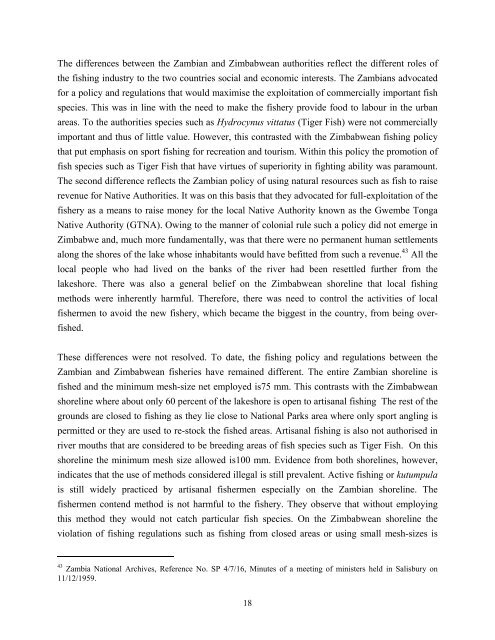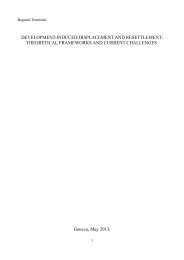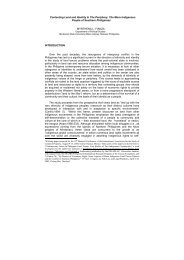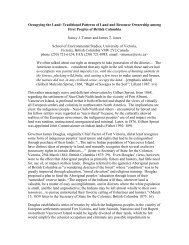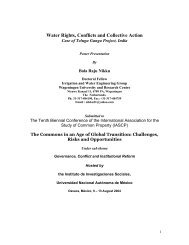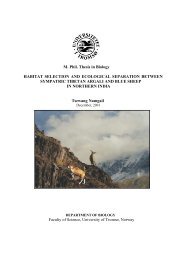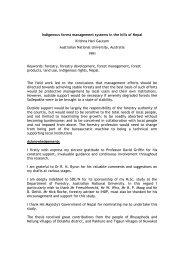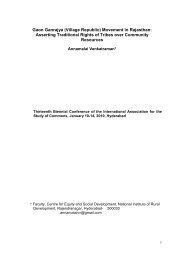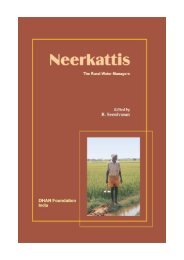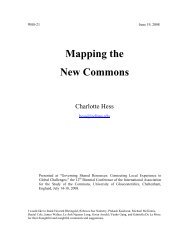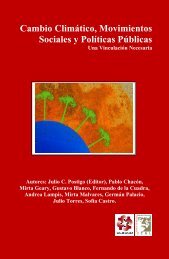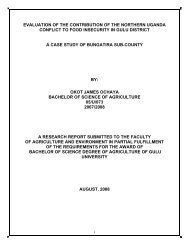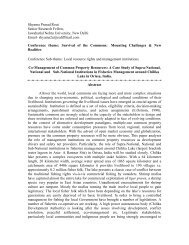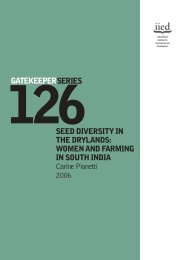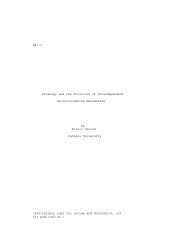The emergence of fisheries legislation and regulations in Zambia ...
The emergence of fisheries legislation and regulations in Zambia ...
The emergence of fisheries legislation and regulations in Zambia ...
Create successful ePaper yourself
Turn your PDF publications into a flip-book with our unique Google optimized e-Paper software.
<strong>The</strong> differences between the <strong>Zambia</strong>n <strong>and</strong> Zimbabwean authorities reflect the different roles <strong>of</strong><br />
the fish<strong>in</strong>g <strong>in</strong>dustry to the two countries social <strong>and</strong> economic <strong>in</strong>terests. <strong>The</strong> <strong>Zambia</strong>ns advocated<br />
for a policy <strong>and</strong> <strong>regulations</strong> that would maximise the exploitation <strong>of</strong> commercially important fish<br />
species. This was <strong>in</strong> l<strong>in</strong>e with the need to make the fishery provide food to labour <strong>in</strong> the urban<br />
areas. To the authorities species such as Hydrocynus vittatus (Tiger Fish) were not commercially<br />
important <strong>and</strong> thus <strong>of</strong> little value. However, this contrasted with the Zimbabwean fish<strong>in</strong>g policy<br />
that put emphasis on sport fish<strong>in</strong>g for recreation <strong>and</strong> tourism. With<strong>in</strong> this policy the promotion <strong>of</strong><br />
fish species such as Tiger Fish that have virtues <strong>of</strong> superiority <strong>in</strong> fight<strong>in</strong>g ability was paramount.<br />
<strong>The</strong> second difference reflects the <strong>Zambia</strong>n policy <strong>of</strong> us<strong>in</strong>g natural resources such as fish to raise<br />
revenue for Native Authorities. It was on this basis that they advocated for full-exploitation <strong>of</strong> the<br />
fishery as a means to raise money for the local Native Authority known as the Gwembe Tonga<br />
Native Authority (GTNA). Ow<strong>in</strong>g to the manner <strong>of</strong> colonial rule such a policy did not emerge <strong>in</strong><br />
Zimbabwe <strong>and</strong>, much more fundamentally, was that there were no permanent human settlements<br />
along the shores <strong>of</strong> the lake whose <strong>in</strong>habitants would have befitted from such a revenue. 43 All the<br />
local people who had lived on the banks <strong>of</strong> the river had been resettled further from the<br />
lakeshore. <strong>The</strong>re was also a general belief on the Zimbabwean shorel<strong>in</strong>e that local fish<strong>in</strong>g<br />
methods were <strong>in</strong>herently harmful. <strong>The</strong>refore, there was need to control the activities <strong>of</strong> local<br />
fishermen to avoid the new fishery, which became the biggest <strong>in</strong> the country, from be<strong>in</strong>g over-<br />
fished.<br />
<strong>The</strong>se differences were not resolved. To date, the fish<strong>in</strong>g policy <strong>and</strong> <strong>regulations</strong> between the<br />
<strong>Zambia</strong>n <strong>and</strong> Zimbabwean <strong>fisheries</strong> have rema<strong>in</strong>ed different. <strong>The</strong> entire <strong>Zambia</strong>n shorel<strong>in</strong>e is<br />
fished <strong>and</strong> the m<strong>in</strong>imum mesh-size net employed is75 mm. This contrasts with the Zimbabwean<br />
shorel<strong>in</strong>e where about only 60 percent <strong>of</strong> the lakeshore is open to artisanal fish<strong>in</strong>g <strong>The</strong> rest <strong>of</strong> the<br />
grounds are closed to fish<strong>in</strong>g as they lie close to National Parks area where only sport angl<strong>in</strong>g is<br />
permitted or they are used to re-stock the fished areas. Artisanal fish<strong>in</strong>g is also not authorised <strong>in</strong><br />
river mouths that are considered to be breed<strong>in</strong>g areas <strong>of</strong> fish species such as Tiger Fish. On this<br />
shorel<strong>in</strong>e the m<strong>in</strong>imum mesh size allowed is100 mm. Evidence from both shorel<strong>in</strong>es, however,<br />
<strong>in</strong>dicates that the use <strong>of</strong> methods considered illegal is still prevalent. Active fish<strong>in</strong>g or kutumpula<br />
is still widely practiced by artisanal fishermen especially on the <strong>Zambia</strong>n shorel<strong>in</strong>e. <strong>The</strong><br />
fishermen contend method is not harmful to the fishery. <strong>The</strong>y observe that without employ<strong>in</strong>g<br />
this method they would not catch particular fish species. On the Zimbabwean shorel<strong>in</strong>e the<br />
violation <strong>of</strong> fish<strong>in</strong>g <strong>regulations</strong> such as fish<strong>in</strong>g from closed areas or us<strong>in</strong>g small mesh-sizes is<br />
43 <strong>Zambia</strong> National Archives, Reference No. SP 4/7/16, M<strong>in</strong>utes <strong>of</strong> a meet<strong>in</strong>g <strong>of</strong> m<strong>in</strong>isters held <strong>in</strong> Salisbury on<br />
11/12/1959.<br />
18


